





In part 3 of this 3 part series, I will discuss the fall-flowering anemone, commonly called the Japanese anemone. For extending the blooming season in your garden, this group of plants is indispensible as they will often bloom well into October or even November.
In part 3, of this three part series on Anemone, I will focus on the fall-blooming species, which, thankfully, encompasses far fewer species than the other two groups. The fall-flowering anemone are commonly called the Chinese or Japanese Anemone, as they are all native to that part of the world. There are three species involved in this group: A. hupehensis, A.tomentosa and A. vitifolia, along with their hybrids collectively called A. X hybrida. All of these anemone have somewhat woody rootstocks and short rhizomes, resulting in clumps that increase gradually with time. In the wild, they inhabit damp, open woodlands and subalpine meadows. In the garden, they appreciate part-shade and consistently moist, highly organic soil. They also do better in areas with ample snow-cover. If this is not reliable, they should be heavily mulched in the fall. Hardiness varies with the species. Anemone tomentosa is the hardiest, being rated for zone 3, while A. vitifolia, A. hupehensis and A. X hybrida are all rated for zone 5 (zone 4 if adequately mulched).
Their leaves are reasonably attractive, being mostly basal and covered in short, stiff hairs. The stems, which reach 60-120 cm, are branched with smaller leaves. Flowering commences in August and continues until cut down by hard frosts. Blooms are saucer-shaped (poppy-like) with rounded petals (botanically they are sepals). The flowers range in colour from white through shades of pink to redddish-purple and may be single, semi-double or double. They make admirable cut-flowers.
The differences between the species is subtle and is based primarily on the leaves. Anemone vitifolia is easy to recognize by its very grape-like leaves. This species is relatively rare in gardens. Both A. tomentosa and A. hupehensis (aka A. japonica) have similar three-parted leaves but the undersides of A. tomentosa are densely hairy and whitish while A. hupehensis are much less so. The hybrids have leaves virtually the same as A. hupehensis but they lack fertile pollen. Anemone tomentosa is mostly available as the cultivar ‘Robustissima' which grows 100-120 cm with numerous light pink flowers that are a bit smaller than A. hupehensis or A. X hybrida. Anemone hupehensis is the shortest species, mostly 60-75 cm, although the variety japonica can reach over 1 m. The most popular selections are: ‘Hadspen Adundance' (dark purplish-pink, single, 60-90 cm) and ‘Albadura' (white, single, 90-110 cm).
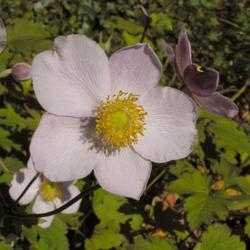
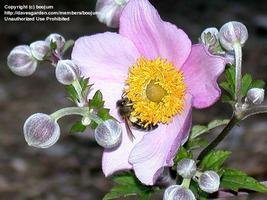
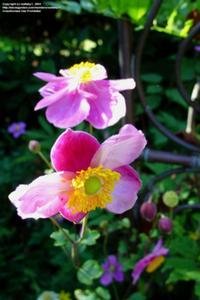
Pictured above is A. tomentosa, A. tomentosa 'Robustissima' and 'Hadspen Adundance'
There are about 30 cultivars of A. X hybrida, but only a few are common in the trade. Perhaps the most popular is ‘Honorine Jobert' with large, pristine white flowers on stems over 100 cm. ‘Andrea Atkinson' is quite similar but shorter (75-90 cm). ‘Whirlwind' is a charming, semi-double, white cultivar (80-110 cm). 'September Charm' is a single flowered, pale pink cultivar listed as either a hybrid or a selection of A. hupehensis, depending on your reference. Another single deeper pink is 'Rosenschale' (aka 'Rose Bowl'). ‘Alice' (60-70 cm) has semi-double light pink blooms while ‘Queen Charlotte' (70-90 cm) has semi-double flowers in light purplish-pink. Other semi-double cultivars with pink-toned flowers are ‘Prinz Heinrich'( aka ‘Prince Henry', 60-80 cm), ‘Bressingham Glow' (60 cm), ‘Max Vogel' (60-90 cm), 'Margarete' (60-90 cm), 'Pamina' (60-70 cm) and ‘Serenade' (60-90 cm).
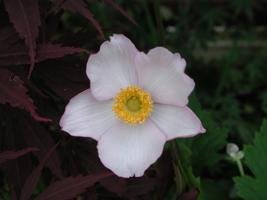
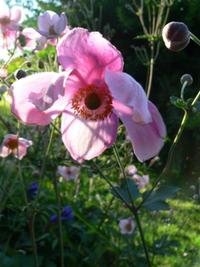
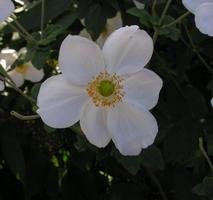
Among the single-flowered hybrids are 'September Charm', 'Rosenschale' and 'Honerine Jobert'
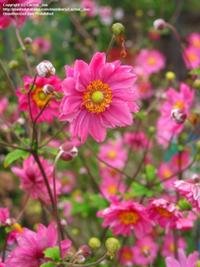
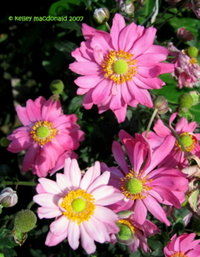
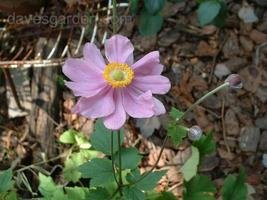
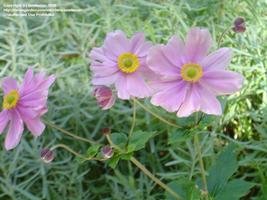
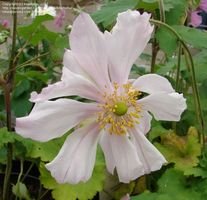
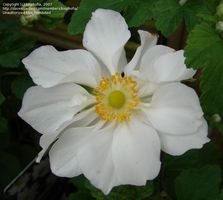
Among the semi-double varieties are 'Margarete', 'Bressingham Glow', 'Prinz Heinrich', 'Serenade', 'Queen Charlotte' and 'Whirlwind'
As a gardener, the fall anemones are indispensable for extending the garden blooming season late into the fall. The flowers are surprisingly frost resistant. They are also of great use for flower arrangers. So if you have not grown them, give them a try.
Many members of Dave's Garden must be thanked for the use of their photos. I obviously need to grow more of these! boojum ('Robustissima' and 'Rosenschale'); cactus_joe ('Margarete'); henry10 ('Prinz Heinrich'); kell ('Bressingham Glow'); kniphofia ('Whirlwind' and 'Queen Charlotte'); lorettamar ('Serenade'); wallaby1 ('Hapsden Adundance')
(Editor's Note: This article was originally published on July 19, 2008. Your comments are welcome, but please be aware that authors of previously published articles may not be able to promptly respond to new questions or comments.)
Copyright © www.100flowers.win Botanic Garden All Rights Reserved